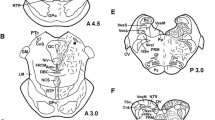Abstract
NEURONE-SPECIFIC ENOLASE (NSE) is the most acidic brain isoenzyme of the glycolytic enzyme enolase (EC4.2.1.11) and has been shown to be homologous to the 14-3-2 protein isolated from bovine brain by Moore1–3. Whereas NSE is exclusively localised in neurones in mammalian nervous tissue4,5, another brain enolase isoenzyme termed non-neuronal enolase (NNE) is localised in glial elements5. As NSE and NNE are structurally, functionally and immunologically distinct isoenzymes that represent separate gene products6,7, they are useful markers for cell classes in the nervous system. Although NNE is probably identical to liver enolase, NSE has to date been considered to be localised in neurones. We now report that NSE is also present in peripheral and central neuroendocrine cells, also termed amine precursor uptake and decarboxylation (APUD) cells8–10. Immunocytochemistry using the unlabelled antibody enzyme method of Sternberger11 demonstrates that APUD cells in both laboratory rat and rhesus monkey (Macacca mulatta) stain positively with NSE antiserum. Using a sensitive radioimmunoassay (RIA) for NSE, it is possible to confirm their localisation in adrenal gland and to support the finding in other APUD-cell-containing tissues in rat, monkey and man. The results in human tissues suggest that the immunocytochemical localisation in rat and monkey will be valid for man and prove useful in the study of human diseases involving the APUD cell class.
Similar content being viewed by others
References
Marangos, P. J., Zomzely-Neurath, C. & Goodwin, F. K. J. Neurochem. 28, 1097–1107 (1977).
Marangos, P. J. & Zomzely-Neurath, C. Biochem. biophys. Res. Commun. 68, 1309–1316 (1976).
Moore, B. W. in Proteins of the Nervous System (ed. Schneider, D. J.) (Raven, New York, 1973).
Pickel, V. M., Reis, D. J., Marangos, P. J. & Zomzely-Neurath, C. Brain Res. 105, 184–187 (1974).
Schmechel, D., Marangos, P. J., Zis, A. P., Brightman, M. & Goodwin, F. K. Science 100, 313–315 (1978).
Marangos, P. J., Zis, A. P., Clark, R. L. & Goodwin, F. K. Brain Res. 150, 117–133 (1978).
Marangos, P. J., Parma, A. M. & Goodwin, F. K. J. Neurochem. 31, 727–732 (1978).
Pearse, A. G. E. Proc. R. Soc. Biol. B. 170, 71–80 (1968).
Pearse, A. G. E. Z. Krebsforsch. 84, 1–18 (1974).
Pearse, A. G. E. Chromaffin, Enterochromaffin and Related Cells, 147 (Elsevier, Amsterdam, 1976).
Sternberger, L. A. Immunocytochemistry (Prentice-Hall, New Jersey, 1974).
Marangos, P. J., Zomzely-Neurath, C. & York, C. Archs Biochem. Biophys. 170, 289–293 (1975).
Sidman, R. L., Mottla, P. A. & Feder, N. Stain Technol. 36, 279–284 (1961).
Marangos, P. J., Goodwin, F. K., Parma, A. M., Lauter, C. & Trams, E. Brain Res. 145, 49–58 (1978).
Tischler, A. S., Dichter, M. A., Biales, B. & Greene, L. A. New Engl. J. Med. 296, 919–925 (1977).
Author information
Authors and Affiliations
Rights and permissions
About this article
Cite this article
SCHMECHEL, D., MARANGOS, P. & BRIGHTMAN, M. Neurone-specific enolase is a molecular marker for peripheral and central neuroendocrine cells. Nature 276, 834–836 (1978). https://doi.org/10.1038/276834a0
Received:
Accepted:
Published:
Issue Date:
DOI: https://doi.org/10.1038/276834a0
- Springer Nature Limited
This article is cited by
-
Traumatic axonal injury: neuropathological features, postmortem diagnostic methods, and strategies
Forensic Science, Medicine and Pathology (2022)
-
Forensic biomarkers of lethal traumatic brain injury
International Journal of Legal Medicine (2022)
-
Neuron-specific enolase has potential value as a biomarker for [18F]FDG/[68Ga]Ga-PSMA-11 PET mismatch findings in advanced mCRPC patients
EJNMMI Research (2020)
-
The CIMP-high phenotype is associated with energy metabolism alterations in colon adenocarcinoma
BMC Medical Genetics (2019)
-
Gamma-enolase predicts lung damage in severe acute pancreatitis-induced acute lung injury
Journal of Molecular Histology (2018)





